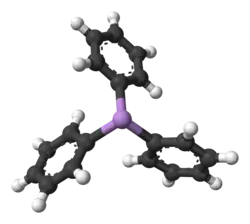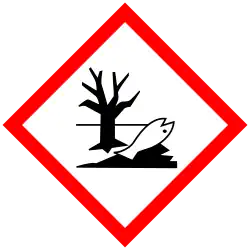Triphenylarsine
 | |
 | |
| Names | |
|---|---|
| Preferred IUPAC name
Triphenylarsane | |
| Other names
Tribenzenidoarsenic
Triphenylarsine | |
| Identifiers | |
3D model (JSmol)
|
|
| ChemSpider | |
| ECHA InfoCard | 100.009.121 |
| EC Number |
|
PubChem CID
|
|
| RTECS number |
|
| UNII | |
| UN number | 3465 |
CompTox Dashboard (EPA)
|
|
| |
| |
| Properties | |
| C18H15As | |
| Molar mass | 306.240 g·mol−1 |
| Appearance | Colourless solid |
| Density | 1.395 g cm−3 |
| Melting point | 58 to 61 °C (136 to 142 °F; 331 to 334 K) |
| Boiling point | 373 °C (703 °F; 646 K) at 760 mmHg |
| Insoluble | |
| Solubility | Soluble in ethyl ether, benzene, slightly soluble in ethanol |
| −177.0·10−6 cm3/mol | |
| Structure | |
| Triclinic | |
| Hazards | |
| GHS labelling: | |
 
| |
| Danger | |
| H301, H331, H410 | |
| P261, P264, P270, P271, P273, P301+P310, P304+P340, P311, P321, P330, P391, P403+P233, P405, P501 | |
| Related compounds | |
Related organoarsanes
|
Trimethylarsine |
Related compounds
|
Triphenylamine |
Except where otherwise noted, data are given for materials in their standard state (at 25 °C [77 °F], 100 kPa).
Infobox references
| |
Triphenylarsine is the chemical compound with the formula As(C6H5)3. This organoarsenic compound, often abbreviated AsPh3, is a colorless crystalline solid that is used as a ligand and a reagent in coordination chemistry and organic synthesis. The molecule is pyramidal with As-C distances of 1.942–1.956 Å and C-As-C angles of 99.6–100.5°.[1]
Preparation
Triphenylarsine is prepared by treating phenyl lithium with arsenic tribromide. The method can be used to prepare many analogues with diverse aryl groups.[2]
Triphenylarsine can also be prepared by the Wurtz-like reaction of arsenic trichloride with chlorobenzene using sodium as the reducing agent:[3]
- AsCl3 + 3 PhCl + 6 Na → AsPh3 + 6 NaCl
Reactions
Reaction of triphenylarsine with lithium gives lithium diphenylarsenide and phenyllithium:[4]
- AsPh3 + 2 Li → LiAsPh2 + LiPh
Triphenylarsine is the precursor to tetraphenylarsonium chloride, [AsPh4]Cl, a popular precipitating agent.[3]
Many metal-arsine complexes have been prepared using AsPh3. Examples include IrCl(CO)(AsPh3)2, RhCl(AsPh3)3, and Fe(CO)4(AsPh3).[5]
Treatment of triphenylarsine with hydrogen peroxide gives triphenylarsine oxide: [6]
- AsPh3 + H2O2 → OAsPh3 + H2O
References
- ^ Mazhar-ul-Haque, Hasan A. Tayim, Jamil Ahmed, and William Horne "Crystal and molecular structure of triphenylarsine" Journal of Chemical Crystallography Volume 15, Number 6 / 1985. doi:10.1007/BF01164771
- ^ Tanaka, Susumu; Konishi, Masafumi; Imoto, Hiroaki; Nakamura, Yuma; Ishida, Masatoshi; Furuta, Hiroyuki; Naka, Kensuke (2020). "Fundamental Study on Arsenic(III) Halides (AsX3; X = Br, I) toward the Construction of C3-Symmetrical Monodentate Arsenic Ligands". Inorganic Chemistry. 59 (14): 9587–9593. doi:10.1021/acs.inorgchem.0c00598. PMID 32515950.
- ^ a b Shriner, R. L.; Wolf, Calvin N. (1950). "Tetraphenylarsonium Chloride Hydrochloride". Organic Syntheses. 30: 95. doi:10.15227/orgsyn.030.0095.
- ^ W. Levason; C. A. Mcauliffe (1976). "Cis -2-Diphenylarsinovinyldiphenylphosphine and 2-Diphenylarsinoethyldiphenylphosphine". cis-2-Diphenylarsinovinyldiphenylphosphine and 2-Diphenylarsinoethyldiphenylphosphine. Inorganic Syntheses. Vol. 16. pp. 188–192. doi:10.1002/9780470132470.ch50. ISBN 978-0-470-13247-0.
- ^ C. A. McAuliffe, ed. (1973). Transition Metal Complexes of Phosphorus, Arsenic, and Antimony Ligands. J. Wiley. ISBN 0-470-58117-4.
- ^ Mollat Du Jourdin, Xavier (2015). "Triphenylarsine Oxide". Encyclopedia of Reagents for Organic Synthesis. pp. 1–3. doi:10.1002/047084289X.rn01860. ISBN 978-0-470-84289-8.